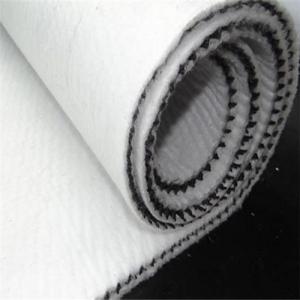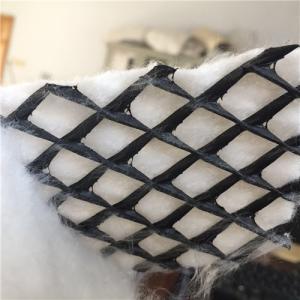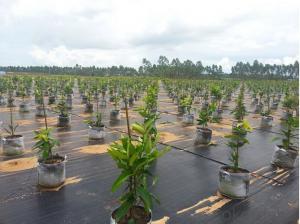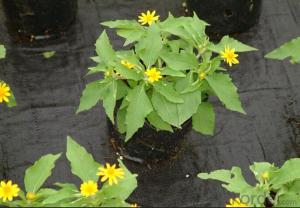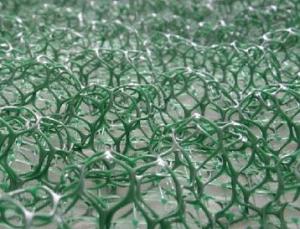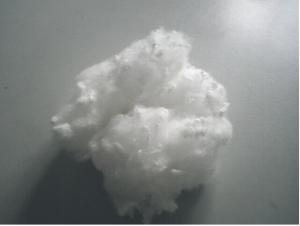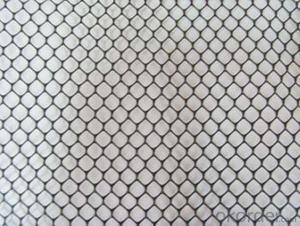Composite Geonet or Drainage for Retaining Back Wall
- Loading Port:
- Qingdao
- Payment Terms:
- TT or LC
- Min Order Qty:
- 1000 watt
- Supply Capability:
- 100000 watt/month
OKorder Service Pledge
OKorder Financial Service
You Might Also Like
Composite Geonet Description:
Composite geonet is a new type drainage material. It has three layers: three-dimensional geonet and nonwoven geotextile on both sides.
The material of geonet is HDPE, and the material of geotextile can be needle punched PET/PP nonwoven geotextile, and thermalbonded continuous filament nonwoven geotextile.

Composite Geonet Specification:
Thickness of geonet: 5mm to 8mm
Weight of geotextile: 200g/m2, as request
Width: 2m-4m
Length: as request
Composite Geonet Property:
Tri-dimension composite geonet has the property of geotextile (filtration function) and geonet (drainage and protection function), it can provide a function system: filtration-drainage-protection. The core of net with its unique tri-dimension structure can bear high
compression load in construction and remain certain thickness, provide good water conductivity.
Composite Geonet Application:
Landfill drainage, roadbed and road drainage, railway drainage, tunnel drainage, underground structure drainage, the retaining back wall
drainage, gardens and sports grounds drainage.
Packaing
Our packing is strong enough to withstand bumping and rough handling under normal condition.
We can accept add customer's logo on the package.
Our Service
1. OEM Manufacturing welcome.
2. Free Sample to see our quality.
3. We will reply you for your inquiry in 24 hours.
4. After sending, we will track the products for you once every two days, until you get the products. When you got the goods, test them, and give me a feedback.If you have any questions about the problem, contact with us, we will offer the solve way for you.
- Q:Can geosynthetics be used for lining wastewater treatment plants?
- Yes, geosynthetics can be used for lining wastewater treatment plants. They are commonly used for their durability and impermeability, which helps prevent leakage and contamination of the surrounding soil and water. Additionally, geosynthetics can provide reinforcement and stability to the lining system, enhancing its overall performance and longevity.
- Q:How do earthwork products contribute to groundwater recharge?
- Earthwork products, such as detention basins and infiltration trenches, play a crucial role in groundwater recharge. These products are designed to capture and store stormwater runoff, allowing it to slowly infiltrate into the ground. By doing so, they replenish the groundwater supply by increasing the amount of water that seeps into the aquifers. This helps to maintain sustainable water levels, improve water quality, and support ecosystems dependent on groundwater.
- Q:What is the cost of earthwork products?
- The cost of earthwork products can vary significantly depending on factors such as the type and quantity of products needed, location, supplier, and market conditions. It is best to contact local suppliers or contractors to get specific pricing information for your project.
- Q:Are earthwork products suitable for coastal erosion control?
- Yes, earthwork products such as geotextiles, geogrids, and erosion control blankets are commonly used for coastal erosion control. These products provide structural stability, slope protection, and soil stabilization, helping to prevent erosion and protect coastal areas. They are effective in managing wave impact, reducing sediment transport, and promoting vegetation growth, making them suitable options for coastal erosion control projects.
- Q:How do earthwork products contribute to slope protection in landslide-prone areas?
- Earthwork products, such as retaining walls, geotextiles, and erosion control blankets, play a crucial role in slope protection in landslide-prone areas. These products help stabilize slopes by providing structural support, preventing soil erosion, and enhancing drainage systems. Retaining walls, for instance, hold back the soil and distribute the pressure evenly, reducing the risk of slope failure. Geotextiles act as a barrier, preventing soil movement and promoting water filtration. Erosion control blankets help establish vegetation, reducing surface erosion and reinforcing the slope's stability. In combination, these earthwork products effectively mitigate the risk of landslides and ensure the safety and resilience of the slopes in such areas.
- Q:How do geosynthetic meshes help in slope stabilization?
- Geosynthetic meshes provide reinforcement and stabilization to slopes by distributing the stresses and loads across a wider area, increasing the overall strength and stability of the slope. They prevent soil erosion and slippage, effectively reducing the risk of slope failure and landslides.
- Q:How are geotextile tubes used in shoreline stabilization?
- Geotextile tubes are used in shoreline stabilization by being filled with sand or other materials to form a barrier against erosion. These tubes are placed along the shoreline to absorb wave energy and reduce the impact of currents, helping to protect the shoreline from further degradation.
- Q:How are geotextile tubes used in sediment dewatering?
- Geotextile tubes are used in sediment dewatering by creating large containment structures that allow water to drain out while retaining the sediment. The tubes are usually filled with sediment slurry and then left to settle. As the water drains through the permeable geotextile fabric, the sediment particles are trapped inside, resulting in dewatered sediment that can be easily disposed of or repurposed.
- Q:Are geosynthetics resistant to chemical degradation?
- Yes, geosynthetics are generally resistant to chemical degradation. They are designed to withstand exposure to various chemicals, including acids, alkalis, and organic solvents, without significant deterioration. However, the specific resistance may vary depending on the type of geosynthetic material and the chemicals involved.
- Q:What are the specific applications of geotextile tubes in earthwork projects?
- Geotextile tubes, also known as geotubes or geotextile containers, have various applications in earthwork projects. They are commonly used for dewatering and containment purposes, such as in shoreline protection, land reclamation, and sediment control. Geotextile tubes can effectively retain and contain sediment, sludge, or other materials while allowing water to drain out. They are also used in erosion control and slope stabilization projects, providing a barrier against soil erosion and reinforcing the stability of slopes. Additionally, geotextile tubes can be utilized for temporary or permanent structures like retaining walls or berms. Overall, their specific applications in earthwork projects contribute to improving site conditions, reducing environmental impact, and enhancing project efficiency.
1. Manufacturer Overview |
|
|---|---|
| Location | |
| Year Established | |
| Annual Output Value | |
| Main Markets | |
| Company Certifications | |
2. Manufacturer Certificates |
|
|---|---|
| a) Certification Name | |
| Range | |
| Reference | |
| Validity Period | |
3. Manufacturer Capability |
|
|---|---|
| a)Trade Capacity | |
| Nearest Port | |
| Export Percentage | |
| No.of Employees in Trade Department | |
| Language Spoken: | |
| b)Factory Information | |
| Factory Size: | |
| No. of Production Lines | |
| Contract Manufacturing | |
| Product Price Range | |
Send your message to us
Composite Geonet or Drainage for Retaining Back Wall
- Loading Port:
- Qingdao
- Payment Terms:
- TT or LC
- Min Order Qty:
- 1000 watt
- Supply Capability:
- 100000 watt/month
OKorder Service Pledge
OKorder Financial Service
Similar products
New products
Hot products
Related keywords


